I. Integrating Women into U.S. Defense and Foreign Policy
The empowerment of women in unstable countries benefits not only them, but all of us. It is, to my mind, a crucial component of a comprehensive approach to the security challenges of the 21stcentury. . . . We should remember that allowing all women to exercise their full rights is not only an obvious moral imperative. It may have far-reaching geopolitical consequences as well.
—Anders Fogh Rasmussen
12th North American Treaty Organization Secretary General
1. What Took Us So Long?
Expanding Opportunities for Women in the Military
By Michael Mullen
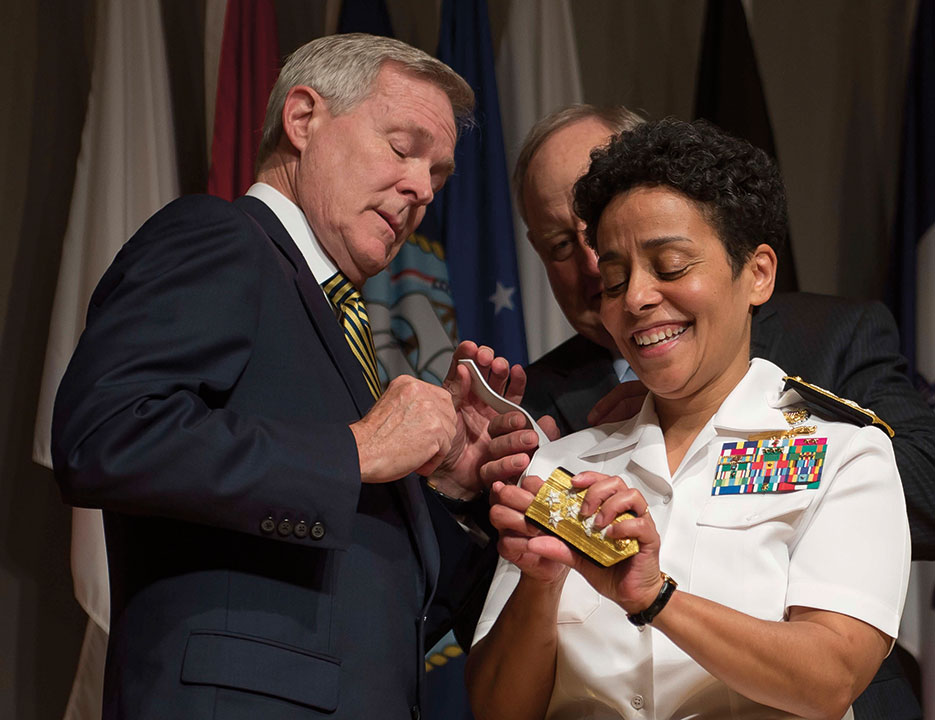
Admiral Michelle Howard lends a hand to Secretary of the Navy Ray Mabus as he and Wayne Cowles, Howard’s husband, put four-star shoulder boards on her Service white uniform during promotion ceremony at the Women in Military Service for America Memorial. Howard is the first woman to be promoted to the rank of admiral in the history of the Navy (U.S. Navy/Peter D. Lawlor)
In 1975, 7 years after I graduated from the Naval Academy, I went back to Annapolis, Maryland, to serve as a staff officer. I was looking forward to a break from life at sea and spending more time with my family. It was, I thought, going to be a respite—the opposite of the constant churn that fleet duty demanded.
Then a telegram arrived one day from Washington, DC, telling us that women would soon join the Brigade of Midshipmen. We were going to have to change. Congress had done the right thing.
So much for my respite. The challenges to come were many.
I began my naval career in the thick of the Vietnam War. I will be the first to admit that a woman’s role in the military was not top—or even near the top—on the list of things that preoccupied me. My high school was all male. The Naval Academy had been all male. The ships I served on were . . . well, you get the idea. If I wanted a woman’s perspective on things, I had to go home to get it. I would like to think that I was not stuck in the Stone Age, but during the Vietnam era, women in the military were anything but equal. Equality was not even a genuine topic of discussion.
I had been selected to serve on the admissions board that would choose the first female Midshipmen about the same time that telegram arrived. There was not much time to get it done. The Naval Academy put together a task force of eight Navy men and one female psychologist. It is fair to say that the psychologist had her hands full. Though we were committed to the task, we were to a large degree ignorant about the challenges these young women would face. But it was a great lesson because it forced us to look at problems as best we could through someone else’s eyes.
That is a lesson that I carried with me throughout my career and it extends far beyond just the issue of diversity: It is vital to have people and voices at the table who, collectively, offer broader perspectives than anyone could alone. There is no question that today as Pentagon leaders consider future efforts to expand opportunities for women in the military, they are not doing so with an 8-to-1 ratio of men to women. And they sure are not doing so with quite the same level of ignorance that we labored under.
Eighty-one women entered Annapolis that first year, joining a military that was less than 5 percent female. I have watched many of them blaze trails and do extraordinary things, opening the way for so many to follow since that telegram 35 years ago. Today, women are rising through our ranks and expanding their influence at an ever-increasing rate, serving magnificently all over the world in all sorts of ways. Each time we open new doors in women’s professional lives—as with former Defense Secretary Leon Panetta’s decision in January 2013 to eliminate the ground combat exclusion rule for women—we end up wondering why it took us so long.
Every Bit as Capable—With an Advantage
You do not have to look hard to see that women have served and sacrificed and led every bit as much—and every bit as capably—as any man. Hundreds of thousands of women have served in Iraq and Afghanistan over the course of the last 12 years, demonstrating tremendous resilience, adaptability, and capacity for innovation. Indeed, they have given us an advantage. For instance, in 2005, when the enemy was using Iraqi women to subvert our security checkpoints, female U.S. Marines began the Lioness Program to counter this threat and conduct broader outreach to the women of Iraq. In Afghanistan, female Marines learned the language and worked with the Afghan people, and often went where male troops could not go. One Afghan elder who opened his home so female Marines could visit with his wife told a Washington Post reporter, “Your men come to fight, but we know the women are here to help.” Of course, all our deployed troops, men and women alike, have the same mission: to fight for and help the local populations. But the different perception matters. Because of it, these women have been able to build relationships and trust with Afghan women, to see things through their eyes, and to gain valuable insight that our operations would not have gained without them.
And U.S. military women are not just exercising soft power. They are courageous fighters as we know from numerous examples. Consider the exploits of Sergeant Leigh Ann Hester, USA. While deployed to Iraq in 2005, Sergeant Hester’s Military Police squad came under withering enemy fire as it tried to protect a 30-vehicle convoy near Salman Pak. Without flinching, she began laying down fire against the insurgents. With another member of her squad, she then charged enemy positions in an irrigation ditch, killing several. Sergeant Hester was awarded the Silver Star for her bravery that day. She became the first woman since World War II so honored, and the first ever cited for close-in combat. She summed up her feelings about those who say women do not belong in combat: “It kind of makes me mad,” she told the Washington Post. “Women can basically do any job that men can.”
Indeed. Time and again, women show us that courage and leadership know no gender. Those who would dismiss the contributions of one gender would sacrifice half the talent, half the resources, half the potential of the population.
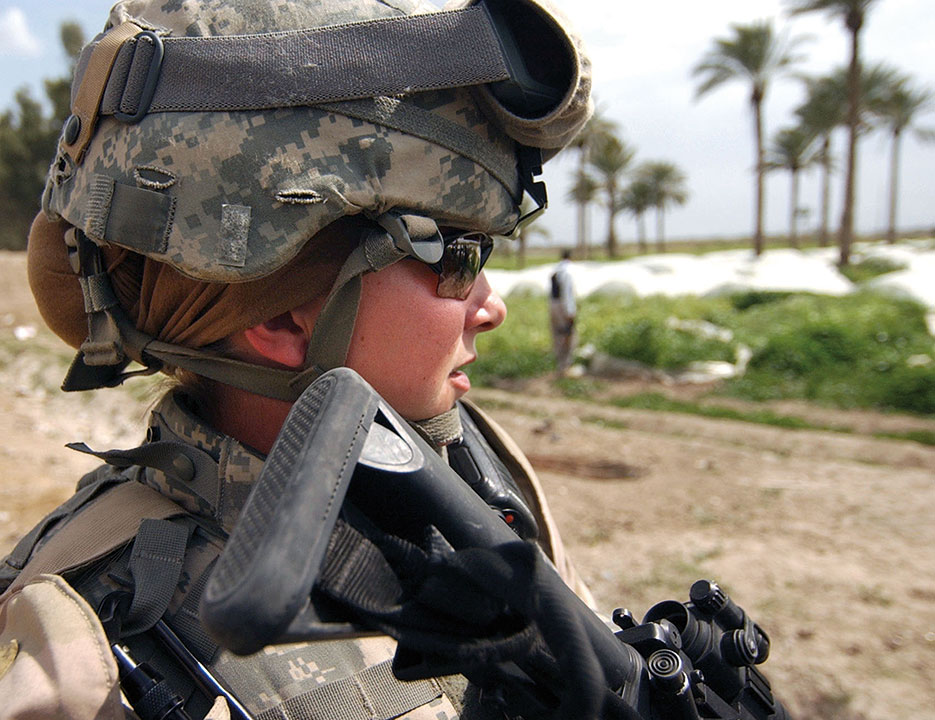
Sergeant Ashley Hort, USA, keeps weapon at ready as she provides security for fellow Soldiers during raid in Al Haswah, Iraq, March 2007 (DOD/Olanrewaju Akinwunmi)
Educate a Girl, Enrich a Community
Of course, the importance of women in peace and security goes beyond serving in the military. As noted in our own National Security Strategy, “countries are more peaceful and prosperous when women are afforded full and equal rights and opportunity. When those rights and opportunities are denied, countries often lag behind.” This is an eternal, if not essential, truth found in the old African proverb, “When you educate a boy, you educate an individual. When you educate a girl, you educate a community.” When these young women grow up, they are the ones who promote the value of education in the community. Infant mortality is reduced. Populations grow at a more manageable rate. The overall quality of health improves. When women are educated, they are less likely to condone or encourage their sons to live outside the norms of peaceful society.
Ultimately, until young people—mostly boys—face better options than strapping on a suicide vest or joining a gang, conflict will persist. So our efforts to educate these communities, to educate women, are more than just the right thing to do; they are essential to our security and to the security of nations and people with whom we partner. Having our own soldiers model the reality of a fully inclusive society helps set the example for the countries we aid.
“If we want to make progress towards settling the world’s most intractable conflicts,” stated former Secretary of State Hillary Rodham Clinton, “let’s enlist women.” I could not agree more. I would only add that the time to act is now, so we do not have to ask, yet again, why did this take so long.
Caring for Our Female Veterans
But even as we recognize how far we have come, we must also consider how far we still have to go—especially in caring for our female veterans, who have served just as ably as their male colleagues. This decade-plus of persistent conflict has had an impact that we are only just beginning to understand, with as-yet-unmeasured costs and undetermined toll. We have sent our Servicemembers into wars that have no clear delineation between the frontlines and the sidelines, where war can come from any direction. As a result, this will be the first generation of veterans in which large numbers of women will have been exposed to some form of combat. And so, just as with their male counterparts, they are returning with wounds visible and invisible. That brings consequences for our healthcare system, our national employment rate, and even homelessness. For instance, women veterans are estimated to make up a relatively small, but growing, proportion of the homeless veteran population. According to Veteran Homelessness: A Supplemental Report to the 2010 Annual Homeless Assessment Report to Congress, homeless women veterans represented 8 percent of veterans living in shelters. Many of these women have young children, who have already been through so much. And many female veterans have been the victims of sexual assault and rape, even at the hands of their fellow troops, which adds an additional burden from which to recover, requiring particular sensitivity and services to treat.
Resources for these women are improving. But so far our offerings for female veterans do not yet match those for their male counterparts. For instance, few homeless programs for veterans have the facilities or the resources to provide separate accommodations for women and women with children. So as we celebrate the doors that have been opened to our women in uniform and honor the impact they have made around the world, we must also look hard at the remaining challenges.
Growing Female Leaders
We do not bring people into the military as senior leaders. It takes generations to grow them. That is why, when it comes to diversity and opportunity, we cannot go fast enough. When we think about diversity in the military, we need to be thinking two generations ahead. In 2040, when my granddaughter turns 30, we will need a military leadership that is truly reflective of—and connected to—the American people. When that day comes and the Chairman of the Joint Chiefs of Staff of 2040 looks at her leadership team, those of us who are still around will not want to have to answer the question, “What took you so long back in 2013?”
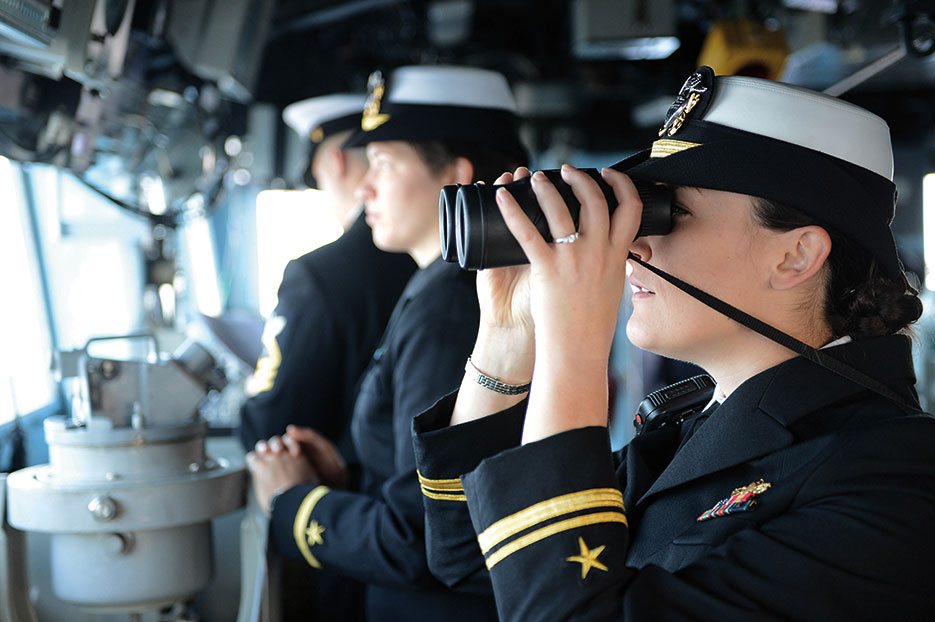
Lieutenant j.g. Stephanie Conte, USN, right, assigned to guided-missile cruiser USS Antietam (CG 54), stands watch as officer of the deck in bridge as ship arrives in Busan, South Korea, October 2013 (DOD/Declan Barnes)
2. Looking through the Gender Lens:
More Stable Peace through Empowering Women
By Donald Steinberg
If I have learned anything from more than three decades working in international conflict resolution and postconflict reconstruction, it is that women must be fully engaged if peace is to succeed. Half of all peace agreements fail within a decade of signature. That tells us that involving women is not just about fairness or rights. Our national security interest in peace, justice, and stability abroad depends on dismantling dangerous past patterns of gendered exclusion and empowering women to contribute to their societies.
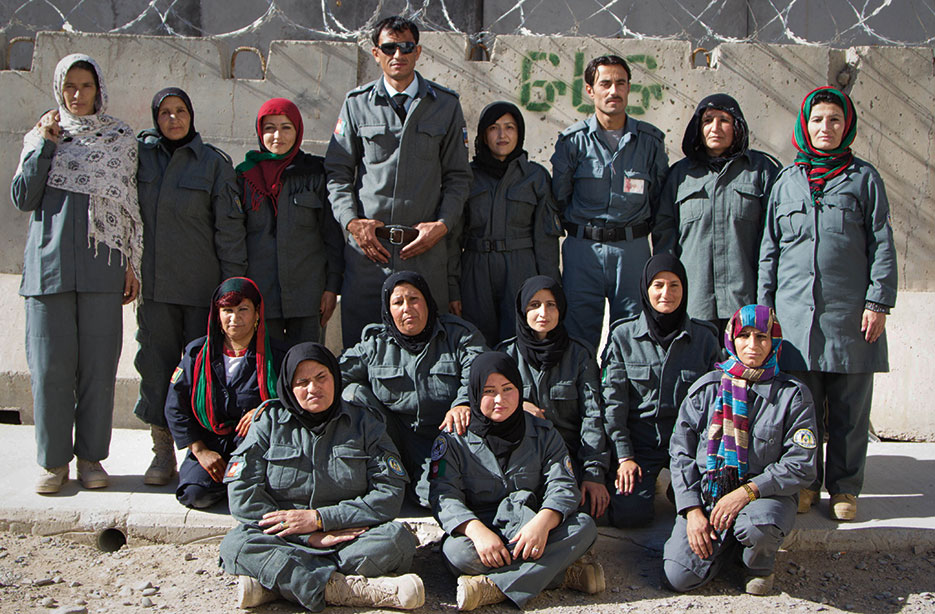
Afghan National Police recruits with their instructors at Joint Regional Afghan National Police Center, Kandahar, Afghanistan, December 2013 (U.S. Army/Mariah Best)
Including Women in Every Decision
When I speak at orientation programs for United Nations officials who will lead peacekeeping operations as Special Representatives and Force Commanders, I remind them that, even in regions where women are excluded from formal leadership, they will get some of their best ideas and most reliable ground truths from the community’s women. If they want to know where the next rebel attack is going to occur, they should not just talk to regional governors or military commanders; they should ask women in the marketplace, whose families’ safety depends on having the latest information. If they want to know whether reforms of the justice and security sectors are working, they should not just talk to the judges or the generals; they should ask women in the community who are seeking justice or who are asking the police and army for protection and safety. If they want to know whether their programs to reintegrate ex-combatants are effective, they should not just talk to the camp managers or demobilization organizers; they should ask the women who are the eyes, ears, and conscience of the communities where these fighters are being returned. And they should not just ask for information; they should involve these women in all programs as planners, implementers, and beneficiaries under the watch phrase, “Nothing about them without them.”
The Lusaka Protocol: Gender Neutrality—or Gender Blindness?
I learned this lesson the hard way. In summer 1994, during the period of the Rwandan genocide and the chaos in Somalia, one of the few hopeful developments in Africa came from Lusaka, Zambia. There the Angolan government, the rebel National Union for the Total Independence of Angola (UNITA) movement, and international mediators were negotiating an end to two decades of Angola’s civil war. As President Bill Clinton’s special assistant for African affairs, I supported these negotiations, which bore fruit in November 1994 with the signing of the Lusaka Protocol. Addressing an audience of African scholars on the protocol in late 1994, I was asked about the role of women in its negotiation and implementation. I responded that not a single provision in the agreement discriminated against women. “The agreement is gender-neutral,” I proclaimed, a little too proudly.
President Clinton then named me U.S. Ambassador to Angola and a member of the Joint Commission charged with implementing the peace accords. It took only a few weeks after my arrival in Luanda to realize that a peace agreement that calls itself “gender-neutral” is actually gender-blind. Failing to consider women and gender as we negotiated and attempted to implement the peace process was a key reason that we failed to implement the protocol—and Angola went back to war in 1998.
Consider the evidence—beginning with the fact that we had no women or representatives from other marginalized groups on the joint commission itself. At each meeting of this body, 40 men and no women—not one—represented the Angolan government, UNITA, the United Nations, Portugal, Russia, and the United States. Not only did this mean we heard no women’s voices on the hard issues of war and peace, but it also meant that we had no women to advocate for resolving such issues as internal displacement, sexual violence, abuses by government and rebel security forces, or rebuilding such social services as maternal healthcare and girls’ education. We were, essentially, half-blind.
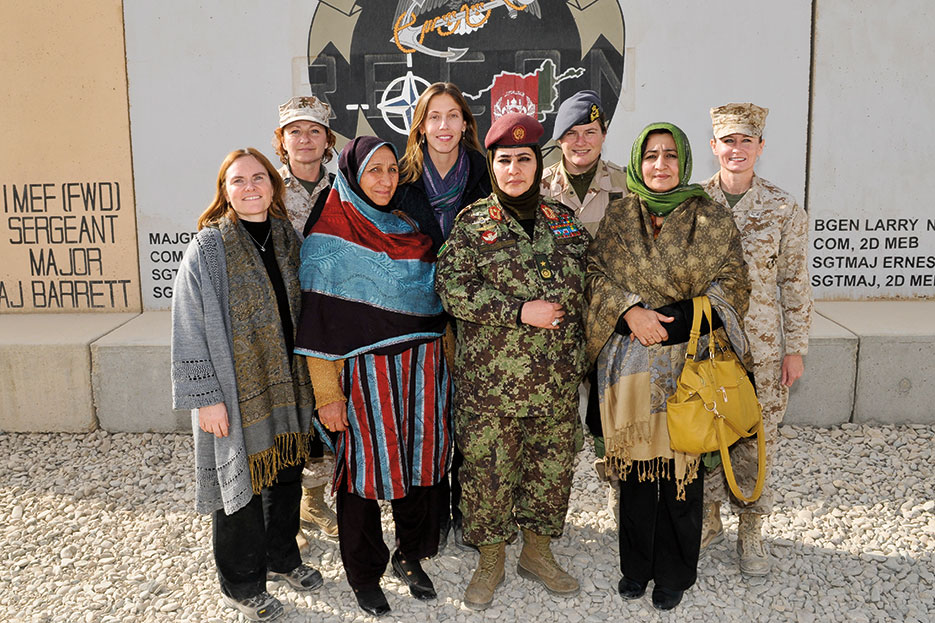
Afghan National Army Brigadier General Khatol Mohammadzai stands alongside other members of both military and civilian services at Regional Command Southwest (Courtesy Royal Air Force/Paul Oldfield)
Without women there to speak about their experiences, wrongdoings against women were either ignored or treated as irrelevant. The peace accord was based on 13 separate amnesties that ruled out prosecution for atrocities committed during the conflict. One amnesty even excused actions that might take place in the future. Sexual abuse and gendered exploitation, including rape as a weapon of war, had been widespread during the conflict. As a result, these amnesties meant that men with guns forgave other men with guns for crimes committed against women. Angolan civil society recognized this flaw and was cynical about the protocol’s promise of a return to the rule of law and accountability. How then could we credibly rebuild and reform their justice and security institutions?
Furthermore, our gender-blind commission could not foresee that the end of the Angolan civil war would unleash a new era of violence against women. As we launched programs to disarm, demobilize, and reintegrate ex-combatants into their communities, we gave these men a little money and demobilization kits, consisting mostly of seeds and farm tools. We then transported them back to communities where they had no clear roles. They lacked marketable skills. Their former communities had learned to live without them during the decades of conflict. And so, as has been true around the world, the soldiers’ return brought a dramatic increase in alcoholism, drug abuse, divorce, and domestic violence. It broke down coping mechanisms that had given women some protection during the conflict. Thus, as men were resettled, women and children suffered.
Even clearing major roads of landmines—an effort to help more than two million refugees and internally displaced persons safely return home—backfired against women in ways they might have foreseen had they been involved in the process of this effort. A dozen separate military forces had boobytrapped Angola with up to a million landmines. Clearing these was an obvious priority. But focusing first on clearing roads meant waiting to clear local fields, wells, and forests. So as newly resettled women went out to plant the fields, fetch water, and collect firewood, they were the ones maimed and killed.

Assistant Secretary of State for Near Eastern Affairs Anne Patterson meets with Saudi Interior Foreign Minister Mohammed bin Nayef in Washington, DC, February 2014 (State Department)
Involve Women in Crafting the Agreements, or Peace Fails
The Lusaka Protocol was largely silent on a wide variety of other issues, including trafficking in persons, rebuilding women’s healthcare, a spike in HIV/AIDS in displaced and mobile populations, the spread of small arms and light weapons into civilian hands, and offering psychosocial assistance to survivors of rape and sexual violence. Gender neutrality when practiced by men turned out to be blindness to half the population. As these realities emerged, we brought out gender advisors and human rights officers to guide efforts to protect and promote women. We supported women’s nongovernmental organizations, and our Embassy launched programs in maternal healthcare, girls’ education, humanitarian demining, transitional justice, and microenterprise.
But it was too little, too late. The peace process was already viewed as serving the interests of the warring parties rather than the Angolan people. Thus, when the peace process faltered in mid-1998 because of insufficient commitment from both the government and especially UNITA leader Jonas Savimbi, civil society stayed on the sidelines and did not press the leaders to prevent a return to conflict. The country went back to war. Another 3 years of fighting ended only with Savimbi’s death in 2002.
Lusaka illustrates the destructive cycle that can result when women are left out of efforts to resolve conflict and rebuild societies. But this example is not unique. In the past 20 years, hundreds of peace treaties have been signed and more than half have failed—noting that fewer than 8 percent of their negotiators and 3 percent of their signatories have been women. Clear evidence shows that involving women expands the agreements’ scopes and improves the prospects for durable peace. Often, women have a greater capacity to work across divisions; they bring different skills and negotiating styles to the table, thereby expanding our array of approaches. Women are also likely to raise critical issues that could, if left unaddressed, threaten the peace—issues such as accountability for past abuses, support for survivors of violence, and redress for social and economic inequalities that contribute to fragility.
Ask: Where Are the Women?
The opposite of gender-blindness is to always be conscious of gender and asking: “Where are the women?” That is our policy at the U.S. Agency for International Development (USAID), whose goal is to promote global development, prosperity, peace, and security—all of which require gender equality and women’s empowerment. We are determined to make gender equality and women’s empowerment a part of our organization’s DNA. Toward that end, in 2012, USAID adopted a suite of mutually reinforcing policies and strategies to close gender gaps, combat gender-based violence and human trafficking, and enable women and girls to realize their rights, influence decisionmaking, and become powerful change agents in their societies.
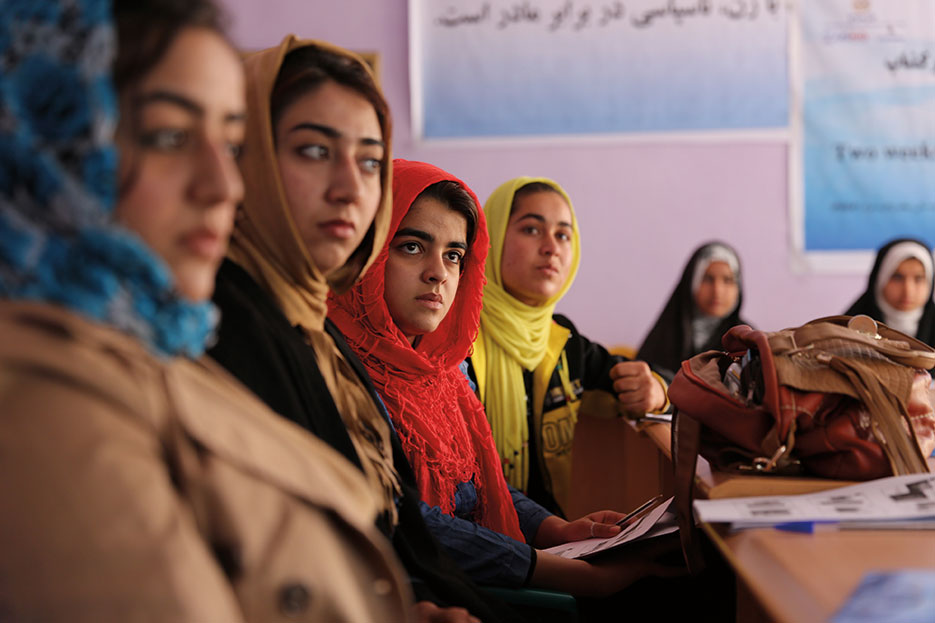
Farahi journalists listen to discussion about photo composition during training at Directorate of Women’s Affairs building in Farah City, Afghanistan, February 2013 (U.S. Navy/Josh Ives)
We now require gender analysis in strategic planning and project design; track what we are spending on gender equity and empowerment; make targeted investments to train and assist women peace-builders, parliamentarians, democracy activists, farmers, and entrepreneurs; and more. For instance, in countries affected by crisis and conflict, USAID is investing in the protection and empowerment of women and girls to foster peaceful, more resilient communities—communities that can better cope with crisis, manage conflict without violence, and stay on a path of development. The U.S. National Action Plan on Women, Peace, and Security, adopted in 2011, serves as a clear roadmap for our efforts:
- Involve women where decisions are made, with the support they need to be effective. For example, in 2011, USAID announced our new Global Women’s Leadership Fund (GWLF) to help women participate in peace negotiations, political transition dialogues, and donor conferences. The fund offers practical support for things such as transportation and childcare as well as strategic support, such as training and capacity-building, to help women leaders create cohesive networks and platforms for action. Since once of the most dangerous professions in the world is that of a female peace-builder, the fund can also pay for physical protection. GWLF supports women in Côte d’Ivoire, Libya, Burma, Afghanistan, Syria, and Pakistan to ensure women’s meaningful participation in conflict resolution, reconciliation, and transition planning. USAID is also connecting local women with national-level dialogues in Mindanao and Yemen and district-level peace committees in Uganda.
- Protect women and girls from violence and exploitation, which not only harm individuals and devastate families, but also undermine the recovery of entire communities. USAID programs help survivors access appropriate medical, psychosocial, legal, and economic services. Where possible, we support models that allow women to access comprehensive services under one roof, such as the innovative 24-hour court being put into place in Guatemala under the leadership of its remarkable attorney general, Claudia Paz y Paz.
- Prevent gender-based violence. Research has given us clear evidence of how to intervene effectively to change men’s attitudes and behaviors—and we are supporting such interventions in countries such as the Democratic Republic of the Congo, Pakistan, Haiti, Uganda, and Ethiopia. Furthermore, we are working to help women and girls use innovative technologies to make them less vulnerable, including solar lighting, fuel-efficient stoves, and mobile phone applications that improve their own security. And we are implementing procedures to hold U.S. personnel, contractors, and grantees to the highest ethical standards in preventing trafficking in persons.
- Protect and empower women in humanitarian crises from the earliest moments of response. For instance, our disaster response staff is trained to advocate, in the field, for designing camps, water points, latrines, and food distributions in ways that promote the safety of women and girls.
- Empower women economically. USAID includes women in early economic recovery efforts through cash- and food-for-work programs. We connect women to longer term opportunities through microfinance programs and through assistance that links women to markets, expands their skills and leadership in business and agriculture, and increases their access to assets such as land and credit.

General Ann Dunwoody, USA, meets with Rear Admiral Liz Young and Air Force Major General Ellen M. Pawlikowski during lunch in her honor in February 2009 at the Women in Military Service for America Memorial at Arlington National Cemetery (U.S. Army)
Keeping America Safe
U.S. national security depends on stable, prosperous, and democratic societies abroad. Countries that protect and empower women do not tend to traffic in illegal drugs, people, or weapons. They do not send off large numbers of refugees across borders and oceans. They do not transmit pandemic diseases. They do not harbor terrorists or pirates. And they do not require American and other international military forces on the ground.
The supposed line between “hard” issues of national security and “soft” issues of human security has vanished forever. There is nothing soft about going after traffickers who turn women and girls into commodities. There is nothing soft about preventing armed thugs from abusing women in refugee camps or holding warlords and other human rights violators accountable for their actions against women. There is nothing soft about forcing demobilized soldiers to refrain from domestic violence or insisting that women have a seat at the table in peace negotiations and a prominent role in peace operations. These are among the hardest responsibilities on our national security agenda, and we ignore them at our peril.